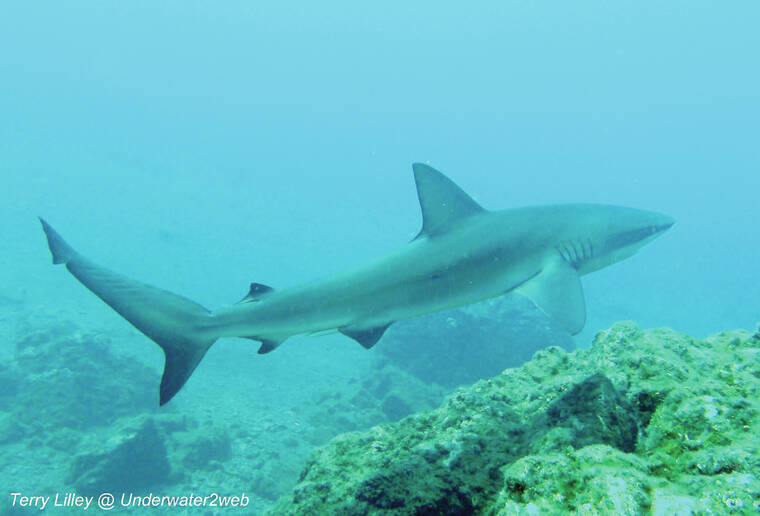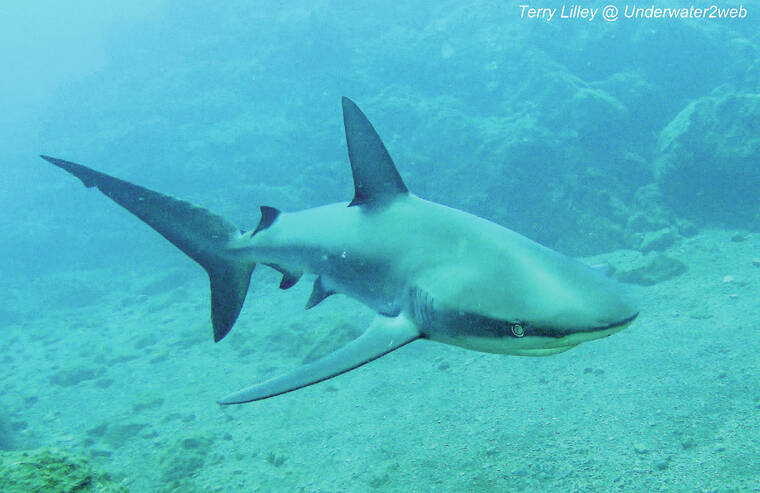In 2016 I was scuba diving at Tunnels Reef (Makua) in Kaua‘i doing a coral study and also spearfishing for roi, which is an invasive grouper species that is damaging our coral-reef ecosystem here in Hawai‘i. I had just speared a large, 18-inch roi and was putting it in my fish bag when a huge shark came out of nowhere and ripped the roi right out of my hands!
I have done over 100 scuba dives at Tunnels and have seen lots of reef sharks and a few tiger sharks, but not once have any of these sharks bothered me underwater until now.
The shark that took the fish out of my hands was different from any shark I had seen in Hawai‘i, and it was over 10 feet long! Where did this bold shark come from?
It turns out that the shark was a big, female Galapagos shark that is rarely seen in the main Hawaiian Islands but is the most common shark species in the Northwest Hawaiian Islands. Why was it at Tunnels Reef in Kaua‘i? After my close encounter with this big shark several other divers had the same shark take fish right off of their spear gun, narrowly missing their hands. Over a six-month period of time this huge shark had terrorized a dozen divers and surfers at Tunnels, and we all decided to stay out of the water for a while to see if the shark would leave. Within about eight months the shark was gone and we have not seen it since, which made us all quite happy.
Galapagos sharks are well known all throughout the warm Pacific seas, and I have now dove with hundreds of these big sharks in the Galapagos Islands and Mexico, where they are very common.
At one time in Mexico only a week ago we were diving with reef sharks, tiger sharks, silver-tipped sharks, hammerhead sharks and Galapagos sharks all at the same time, off of Socorro Island! Almost all of the sharks left when the divers showed up because they did not want anything to do with people, but the Galapagos sharks came right up to us and circled around us only a few feet away for over 10 minutes. We got some great pictures and video and never felt threatened. But we were not spearfishing.
Galapagos sharks usually feed on bottom fish, and they are extremely bold and fast. Most shark species only feed on sick or wounded fish because they are too slow to catch a live, healthy fish, but the Galapagos will chase down a large parrot-fish by cornering it in a crack in the reef. It is just wild watching these sharks feed, but you do not want to get in between the shark and its prey, as this shark species is just not afraid of humans!
The Galapagos shark has been observed in the NW Hawaiian Islands feeding on baby monk seals.
Over the past 10 years monk seals living in the NW Hawaiian Islands have been migrating to the main Hawaiian islands. That may be due to all of the Galapagos sharks eating their babies. It would only be natural that some of the Galapagos sharks would follow the monk seals to Kaua‘i and O‘ahu waters, so we may see more of these aggressive sharks in the future, and spear fishermen should be on the lookout for them.
Like all shark species, they are not dangerous to humans because we are not on the sharks’ menu, but when you spearfish it is a good idea to not keep the wounded fish in a bag strapped to your waist because the Galapagos sharks will try to remove it and you could get bit in the process!
You can see these big, beautiful sharks in action on my underwater educational web page, underwater2web.com and on my YouTube at Underwater2web. I will have a new movie out soon about the big sharks that live in Mexico and Hawai‘i.
•••
Terry Lilley is a marine biologist living in Hanalei and co-founder of Reef Guardians Hawai‘i, a nonprofit on a mission to provide education and resources to protect the coral reef. To donate to Reef Guardians Hawai‘i go to www.reefguardianshawaii.org.



